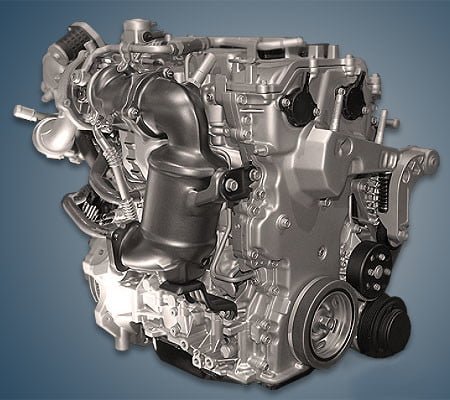0. Introduction:
In today’s discussion, we embark on a journey to explore a selection of international car models equipped with 1.5T engines. Why the focus on 1.5T, you ask? It all stems from China’s intricate engine displacement tax policies and stringent emission regulations, leading to the establishment of the unique 1.5-liter displacement category. As a result, 1.5T engines, whether naturally aspirated or turbocharged, have become the reigning champions in today’s automotive market. Many vehicles that once boasted 2.0L or 2.5L naturally aspirated engines have made the switch to these efficient 1.5T powerplants. Our focus today is primarily on these engines, accompanied by insights into the vehicles that house them.
1.Unleashing Efficiency: China Volkswagen’s 1.5T EA211 EVO Breakdown
When it comes to automotive engineering, staying ahead of the curve is essential. Volkswagen understands this principle well, and they’ve showcased their commitment to innovation with the introduction of the latest 1.5T engine from the Volkswagen Group’s EA 211-DSV EVO series.

1.1 Cutting-Edge Technology
Let’s dive into the technical marvels that make this new 1.5T engine truly exceptional. It employs the Miller cycle, a clever refinement of the traditional Otto cycle. By strategically closing the intake valves earlier, this engine reduces the volume of air entering the cylinders, subsequently lowering internal pressure and temperature. The result? Reduced fuel consumption and emissions.
But that’s just the beginning. Volkswagen has incorporated a range of cutting-edge technologies to enhance daily driving:
Variable Geometry Turbocharger: This turbocharger adjusts its inlet cross-sectional area based on engine speed and load. The outcome is reduced turbo lag, improved low-end torque, and enhanced high-speed efficiency.
350-bar Fuel Injection System: Operating at high pressure, this direct fuel injection system atomizes fuel more finely within the cylinders, boosting combustion efficiency and power output.
Mid-position High-Speed Adjustable Variable Valve Timing: This system dynamically adjusts the timing and duration of intake and exhaust valve opening, optimizing valve timing for different driving conditions, and improving overall engine efficiency.
1.2 Performance Boost
In terms of performance, the new 1.5T engine outshines its predecessor, the 1.4T, in both maximum torque and the range of available rpm. With a 7.3% increase in maximum power and an extended rpm range, the 1.5T engine delivers stable and robust power across a broader spectrum of engine speeds. Test data reveals that vehicles equipped with this engine, such as the Tayron and others, can shave around 0.5 seconds off their 0-100 km/h acceleration times.
Moreover, Volkswagen has fine-tuned the pairing of this 1.5T engine with a seven-speed dual-clutch transmission, resulting in an excellent driving experience. Notably, this powertrain combination excels in fuel efficiency. Compared to the 1.4T engine, the new 1.5T reduces fuel consumption by a remarkable 30% under WLTC conditions, and around 10%-15% in other driving scenarios. These impressive gains are attributed to technologies like the Miller cycle and the variable geometry turbocharger.
1.3 Availability and Future Prospects
While this engine has been in production in Germany since 2021, its rollout in China faced delays due to the COVID-19 pandemic. As of now, approximately six to seven models feature this 1.5T engine in China. These models include the Tiguan L 300TSI, Lavida 1.5T 300TSI, Tharu 2023 300TSI New Moon Edition, T-cross 2023 300TSI, Tayron 2024 300TSI, T-ROC 2023 300TSI, and Sagitar 300TSI.
Looking ahead, the eighth-generation Golf will gradually introduce versions with the 1.5T engine this month, further diversifying Volkswagen’s product lineup. By 2024, the Passat and Magotan are also expected to adopt the 1.5T engine, replacing the earlier 1.4T powerplants. While Volkswagen initially aimed to complete the transition from 1.4T to 1.5T Evo engines in China by the end of 2024, it now appears that this timeline may extend to mid-2025. Nonetheless, it’s worth considering that the present moment might be an opportune time to explore vehicles equipped with the 1.4T engine.
2. Honda’s L15 Series Engine: Power and Precision
When it comes to 1.5T engines, Honda’s L15 series is a name that enthusiasts and drivers alike hold in high regard. Widely used by Honda in China, this powerplant is a testament to Honda’s engineering excellence.

2.1 The VTEC Advantage
At the heart of this engine lies Honda’s signature VTEC (Variable Valve Timing and Lift Electronic Control) system combined with valve lift control. This advanced technology allows for precise control of valve opening and lift under various driving conditions, enhancing both compression ratios and thermal efficiency. The result? A finely tuned balance between power and fuel efficiency.
Honda’s VTEC system has earned its reputation in the automotive industry, and it’s a key reason why this engine stands out. But what does this mean for your driving experience?
2.2 Dynamic Power Delivery
Vehicles equipped with the L15 series engine exhibit direct and responsive power delivery. Impressive low-end torque performance, with a broad torque release range (1600-5000 rpm), ensures a noticeable push when accelerating. Even though some models come with a CVT (Continuously Variable Transmission), the transmission pairing is well-executed, eliminating the typical CVT sluggishness and delivering a seamless driving experience.
2.3 Variants and Performance
The L15 engine comes in multiple variants, with power outputs varying slightly. The high-power variant can produce up to 192-194 horsepower and a peak torque of 260 Newton-meters. Meanwhile, the low-power configuration offers 182 horsepower and 240 Newton-meters of torque. These differences are subtle but can cater to different driving preferences.
2.4 Honda Models With the L15 Engine
Now, let’s take a look at some of the Honda models that feature the L15 engine:
| Honda Model 1 | Honda Model 2 |
| Honda CR-V 2023 240 Turbo | Honda Breeze 2023 240 Turbo |
| Honda Civic 2023 240 Turbo CVT | Honda Integra 2023 240 Turbo CVT |
| Honda Accord 2024 260 Turbo | Honda Insight 2023 260 Turbo |
| Honda ZR-V 2023 240 Turbo | Honda HR-V 2023 240 Turbo |
| Honda UR-V 2023 240 Turbo | Honda Avancier 2023 240 Turbo |
It’s worth noting that the Honda Insight is essentially the twin of the Honda Accord, thanks to the strategy of international brands like Honda, Toyota, and Volkswagen, which operate with two assembly plants in China, resulting in similar twin models.
As a savvy buyer, choosing between these twin models can be an opportunity to secure a great deal, especially towards the end of the year.
3. Nissan X-Trail’s KR15 Engine: Pioneering Performance in China
3.1 Nissan’s Groundbreaking KR15 1.5T Engine
The Nissan X-Trail, powered by the innovative KR15 1.5T engine from the Nissan-Renault alliance, exemplifies cutting-edge automotive technology. The engine features Nissan’s revolutionary VC-Turbo technology, which intelligently adjusts compression ratios from 8:1 to 14:1 to enhance performance and efficiency. This technology, initially acclaimed in the new Altima 2.0T engine, demonstrates Nissan’s commitment to innovation.

3.2 Performance and Efficiency: The KR15’s Edge
With a potent 204 horsepower and a peak torque of 300 Nm, the KR15 engine sets a new standard in performance. Its WLTC fuel consumption of 5.8L/100km highlights its efficiency. The engine’s high RPM capabilities reveal a remarkable power delivery, making the X-Trail a top contender in China’s compact SUV segment.
3.3 Three-Cylinder Design: A Bold Step in Engine Technology
Nissan’s choice of a three-cylinder design for the KR15 in the X-Trail is both bold and strategic. Despite some skepticism in the Chinese market, this engine maintains low vibration and noise levels, showcasing Nissan’s advanced engineering. The X-Trail, with this engine, continues to be a popular choice in China’s compact SUV market.
3.4 Market Dynamics: China’s Perception of Three-Cylinder Engines
In China, the preference often leans towards four-cylinder engines, but the KR15 engine challenges this notion. Nissan’s strategy to offer a three-cylinder option alongside traditional four-cylinder engines in the X-Trail reflects a response to diverse consumer preferences.
3.5 The X-Trail 1.5T: A Smart Choice
The Nissan X-Trail equipped with the KR15 1.5T engine emerges as an excellent choice in the compact SUV category. It combines a modern design, spacious interior, and a vibrant, tech-oriented interior design. The model’s powerful performance and improved fuel efficiency, complemented by attractive discounts, make it a compelling option for Chinese consumers. The Nissan X-Trail with the KR15 1.5t engine represents a harmonious blend of innovative design, powerful performance, and efficiency. It stands as a strong contender in the compact SUV market, particularly for those in China who appreciate advanced engine technology.
4. Hyundai-Kia’s G4 FS 1.5t Engine: Powering China’s Preferred Models
4.1 Innovative Engineering: The G4 FS 1.5t Engine in Hyundai-Kia’s Lineup
The G4 FS 1.5t engine from the Hyundai-Kia Group is a testament to advanced automotive engineering. Currently featured in several popular models, including Kia’s Seltos, Hyundai Tucson L, Hyundai Sonata, and Kia K5, this engine is a powerhouse of performance. It offers a maximum power output of 200 horsepower and a peak torque of 253 Nm. With a WLTC fuel consumption of 6L/100km, it showcases impressive efficiency.

4.2 CVVD Technology: Enhancing Efficiency and Performance
At the core of the G4 FS engine is Hyundai-Kia’s CVVD (Continuously Variable Valve Duration) technology. This system intelligently controls the valve opening angles based on different driving conditions, significantly improving fuel efficiency and performance. It stands as the latest technological achievement from Hyundai-Kia, being the only system in the market that can continuously adjust valve durations.
4.3 Performance Insights: Strengths and Areas for Improvement
The engine’s performance is notably robust, especially evident at mid to high RPMs, where its acceleration capabilities shine. However, it shows some room for improvement in low-torque performance and responsiveness. The engine, when paired with an 8AT transmission, faces minor challenges with shift logic clarity, leading to a perceptible jerkiness. It’s important to note, though, that such transmission-related nuances are common across various models.
The G4 FS 1.5t engine is a significant highlight in Hyundai-Kia’s lineup, offering a blend of power and efficiency. While there are areas for improvement, its overall performance, particularly in models like the Kia Seltos and Hyundai Tucson L, makes it a worthy choice for consumers in the Chinese market, especially for those who value cutting-edge engine technology.
5. Conclusion
The four 1.5t engines we’ve discussed represent the mainstream configurations from major automotive brands. Among these, Nissan’s KR15 engine stands out with its superior numbers, delivering up to 204 horsepower and 300 Nm of torque. This is despite the engine being a three-cylinder model, a type that typically faces market skepticism in China. The other engines generally offer between 160 to 200 horsepower and torque in the range of 250 to 260 Nm. Volkswagen’s approach has been more cautious, possibly eyeing the potential of a high-powered version of the 1.5T engine to replace the lower-powered versions of the EA888 2.0t engine, aligning with manufacturing cost reductions and emission standards.
However, the most notable challenge seems to be for the Nissan KR15 engine, not only due to the Chinese market’s bias against three-cylinder engines but also because of the limited number of models utilizing it, lacking extensive market testing. Additionally, Nissan’s market performance has been sliding, adding to the engine’s challenges.
On the other hand, Honda’s L15 series appears to be the most mature among the four, in both its high and low-power versions. Honda’s consistent control over core engine technology ensures a wide range of compatible models and exceptional stability, making the turbocharged engine feel as smooth as a naturally aspirated one.
Lastly, Hyundai-Kia’s G4FS engine stands out for its stability and reliability, contributing significantly to Hyundai’s strong market performance in recent years. Models like the Tucson and Seltos, equipped with the G4FS, offer attractive pricing and are worthy considerations. They mainly serve as replacements for the 2.0L naturally aspirated engines, affected by increased costs due to displacement taxes.


